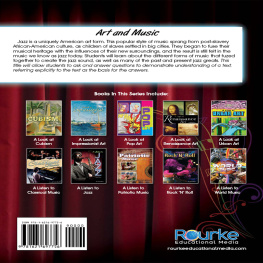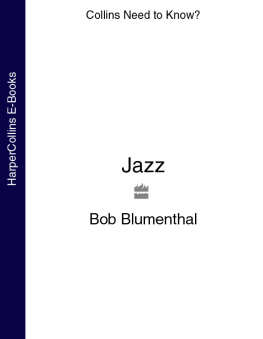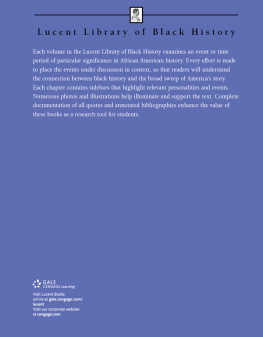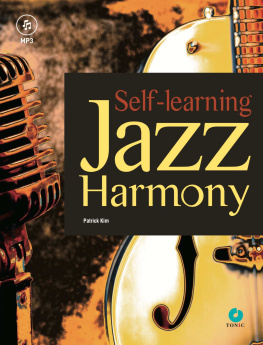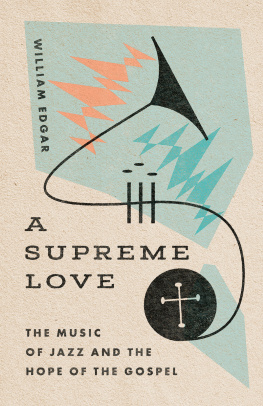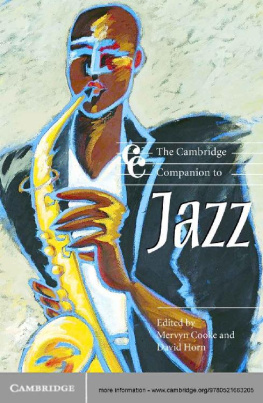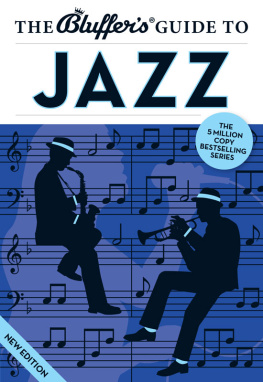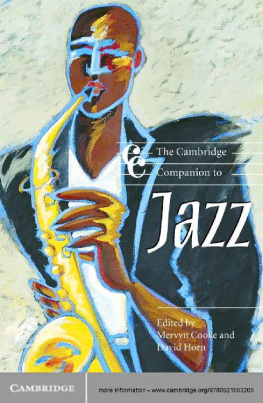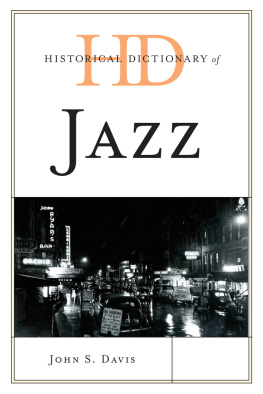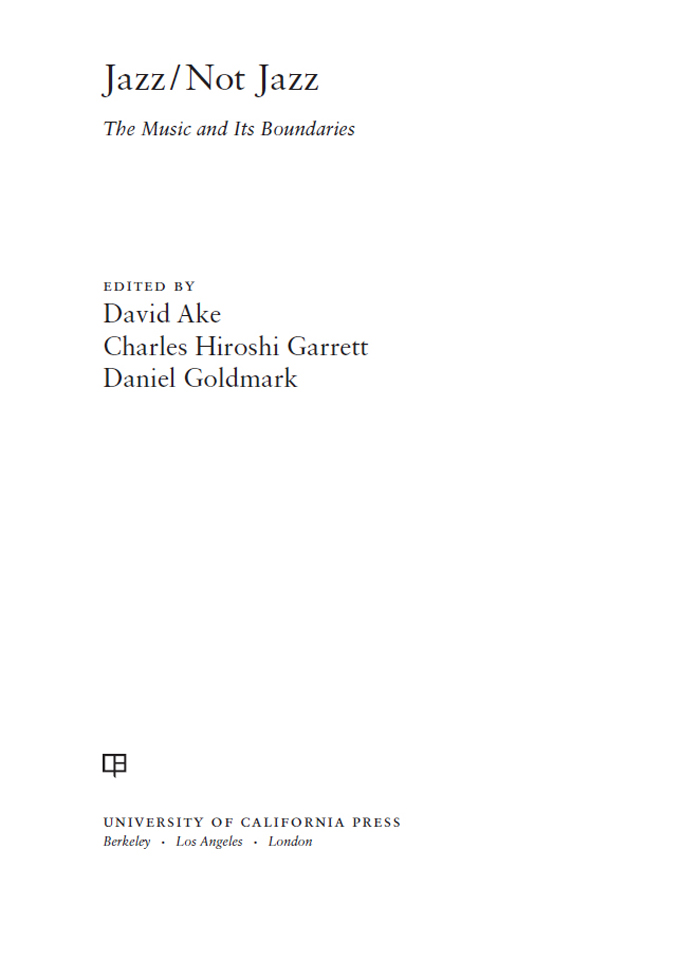Jazz/Not Jazz

ROTH FAMILY FOUNDATION
Music in America Imprint
Michael P. Roth
and Sukey Garcetti
have endowed this
imprint to honor the
memory of their parents,
Julia and Harry Roth,
whose deep love of music
they wish to share
with others.
Jazz/Not Jazz
The Music and Its Boundaries
EDITED BY
David Ake
Charles Hiroshi Garrett
Daniel Goldmark

University of California Press, one of the most distinguished university presses in the United States, enriches lives around the world by advancing scholarship in the humanities, social sciences, and natural sciences. Its activities are supported by the UC Press Foundation and by philanthropic contributions from individuals and institutions. For more information, visit www.ucpress.edu.
University of California Press
Berkeley and Los Angeles, California
University of California Press, Ltd. London, England
2012 by The Regents of the University of California
Library of Congress Cataloging-in-Publication Data
Jazz/not jazz : the music and its boundaries / edited by David Ake, Charles Hiroshi Garrett, Daniel Goldmark.
p. cm.
Includes bibliographical references and index.
ISBN 978-0-520-27103-6 (cloth : alk. paper)
ISBN 978-0-520-27104-3 (pbk. : alk. paper)
ISBN 978-0-520-95135-8 (ebook)
1. JazzHistory and criticism. I. Ake, David
Andrew, 1961II. Garrett, Charles Hiroshi, 1966III. Goldmark, Daniel.
ML3506.J465 2012
781.65dc23
2012003400
Manufactured in the United States of America
21 20 19 18 17 16 15 14 13 12
10 9 8 7 6 5 4 3 2 1
In keeping with a commitment to support environmentally responsible and sustainable printing practices, UC Press has printed this book on 50-pound Enterprise, a 30% post-consumer-waste, recycled, deinked fiber that is processed chlorine-free. It is acid-free and meets all ANSI/NISO (z 39.48) requirements.
Contents
Eric Porter
Elijah Wald
Charles Hiroshi Garrett
Ken Prouty
Christopher Washburne
John Howland
Daniel Goldmark
Tamar Barzel
Loren Kajikawa
Jessica Bissett Perea
David Ake
Sherrie Tucker
Illustrations
FIGURES
MUSICAL EXAMPLES
TABLES
Acknowledgments
The editors extend their deepest appreciation and thanks to the anonymous readers of our drafts; to our indefatigable editor, Mary Francis; and to Eric Schmidt, Kim Hogeland, and everyone at UC Press.
Individually, we offer the following thanks.
From David: To my wife, Kendee Franklin; my son, David Abraham Case Ake; and my colleagues and students in the School of the Arts at the University of Nevada, Reno.
From Charles: To Saleema Waraich and our families, and to my students and colleagues at the University of Michigan, Ann Arbor.
From Daniel: To Cyleste Collins, Milo Goldmark, and Chloe Goldmark; my family; and my students and colleagues at Case Western Reserve University in Cleveland, Ohio.
Introduction
In December 2009 Englands Guardian newspaper Leaving aside the supposed dangers (or definitions) of mere contemporary music, this admittedly unusual legal case highlights a reality of which jazz people today are acutely aware: the lines some people draw between jazz and not jazz can be at once both fiercely guarded and very difficult to discern.
Jazz has never been a monolithic genre, of course, and questions surrounding its definition, ownership, and function hardly emerged with the new millennium. Early critical reception to the music was characterized by clashes between those who heard it as primitiveoftentimes corresponding to a broadly racialized, sometimes explicitly racist, conception of composition and performanceand those who celebrated its innovative rhythmic schemes, timbral nuances, and sheer vitality. Commentators at midcentury questioned whether jazz was best understood as a folk expression, a commercial dance style, or an art form deserving of serious treatment alongside highbrow European compositions. Sweet versus hot, trad versus swing (versus bop), electric versus acoustic, avant-garde versus mainstream: these and other debates have been part and parcel of the jazz world for decades and continue to this day. Even such a large-scale and well-meaning attempt as Ken Burnss 2001 documentary, Jazz, to crystallize and celebrate the genres essence only set off a new flurry of arguments and counterarguments.
No doubt, these more recent
But jazzs specific quarrels and dilemmas are also based in and intensified by the rather unique predicament in which the music now finds itself. Call it an identity crisis, if you will, set off in large measure by jazzs meteoric rise from humble, even despised, origins, through global popularity during the swing era, to its current position near the highest reaches of the established cultural hierarchy (and seeming invisibility in most other quarters), a status that has only exacerbated deep-set anxieties over the relevance, health, and future of the art form. And yet despite (or is it because of?) all this apparent confusion, contention, and change, jazz appreciation classes, textbooks, fan magazines, films, and record company advertisements continue to extol many of the same musicians, places, and sounds that they have for decades. Its a paradoxical time for the jazz world in many ways.
Jazz/Not Jazz addresses just this paradox. Accepting that definitions of jazz have been malleable and contested throughout the musics history, these chapters consider some of the musicians who (and concepts, places, and practices that), though deeply connected to established jazz institutions and aesthetics, have rarely, if ever, appeared in conventional jazz narratives. Our goal here is not to map out a supposedly all-inclusive history of jazz, nor even necessarily to salvage the reputations of typically dismissed styles or figures, but rather to explore what these missing people and pieces tell us about the ways in which jazz has been defined and its history told. That is, in focusing our inquiries beyond the veritable hall of jazz greatness we seek to determine what we can learn about jazz as a whole by interrogating its traditionally understood musical and cultural margins (though not necessarily the economic margins: many of the performers and performances discussed in these chapters have been enjoyed by millions of listeners) and to find out what is gainedand what is lostwhen particular communities erect their own fences around jazz. As Sherrie Tucker states in her chapter, We need not only to study those who are missing from the canon but to understand the desires for particular narratives that exclude them.
To be sure, a number of Yet while other studies have raised important questions about genre, canon, and identity in jazz, this is the first collection to set its sights straight on such a broad range of artists, institutions, and aesthetics. By examining how and why jazz boundaries have been drawn and redrawn, our contributors seek to trouble some of the assumptions on which jazz lore has long rested.


